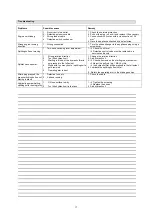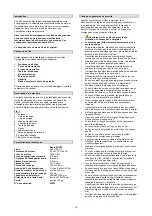
Electric connection (pic. 6)
Plugging
All switches have been fitted with an undervoltage release
included in the switch in accordance with provisions of
specialised professional organisations “CE“, etc. The
undervoltage release prevents appliance self-starting in
case supply is interrupted as a result of supply failure,
unintentional unplugging, defective fuse, etc. The
appliance must necessarily be restarted by pressing the
green On/Off button.
•
The appliance meets EN 61000-3-11 requirements
and is subject to special connection conditions. That
means using the appliance on any connection points is
not allowed.
•
The appliance may cause temporary voltage
fluctuations in case of unfavourable network conditions.
•
The appliance has solely been designed to be used on
connection points not exceeding the maximum
allowable system impedance of Z
max
= 0,233
Ω
.
•
Being the user, you must make sure – after an
agreement with your energy supplier if necessary -
that your connection point on which you want to
operate the appliance meets the above-mentioned
requirement.
Plugging
Check regularly the feeder cables for any damage. Make
sure the feeder cable is not plugged during the check.
Feeder cables must meet the appropriate VDE and DIN
provisions. Feeder cables with H 07 RN marking to be
used only. Providing a type designation on the feeder
cable is required.
Defective feeder cables
Insulation gets often damaged on the feeder cables.
Possible causes include:
•
Crushing if feeder cables are fed in gaps below
windows or doors.
•
Breaks as a result of unauthorised fastening or
feeding of feeder cables.
•
Breaking off or jamming caused by running over the
feeder cables.
•
Insulation damage by pulling the cable out of the
socket in the wall.
•
Cracks as a result of insulation aging.
These defective feeder cables must not be used
and are dangerous to life due to the insulation
damage!
400 V/ 50 Hz three-phase engine
•
400 V / 50 Hz system voltage.
•
The connection to the network and extension cable
must have 5 cores = 3 P + N + SL. – (3/N/PE).
•
Extension cables must have a minimum cross section
of 2.5 mm
2
.
•
Connection to network is protected by at least a 16 A
steady fuse.
Only for 400 V appliances: It is necessary to respect
the engine running direction (see the arrow on the
engine) as operation with a wrong running direction
may damage the oil pump. In such a case, all claims
arising from the warranty do not apply. If necessary,
have an electrician to change the running direction by
changing the plug poles.
See pic. 6! (for three-phase models only!)
Safety instructions to the operator
When repairing, servicing or leaving the wood splitter it is
necessary to interrupt the power supply by pressing the
red button on the switch
and
unplugging the appliance.
Interrupting the power supply just by turning the
switch to the OFF position is not enough.
The GÜDE
wood splitters are always supplied with hardened splitting
knives. However, if you identify any slight deformation of
the splitting knife edge after splitting wood containing
invisible undesirable items, e.g. out of concrete, steel, etc.,
remove the deformation with a file or grinding off. Keeping
the splitting knife sharp at all times increases the working
output.
TIP: From time to time, lubricate the splitting knife with
fat (for problem wood).
Before putting the splitter into operation for the first
time, it is necessary to check whether the safety
equipment (two-lever operation, in particular) is
working properly.
CAUTION! Before putting the appliance into operation,
make sure the splitting table is fitted safely on the
splitter.
Operation (pic. 1)
Bleed the tank by unscrewing and re-screwing
the filling bolt (pic. 1/11) every time the appliance is to
be operated.
Caution: Make sure wood is split at right angle
and closely sits on the splitting table if possible. Wood
split sideways or extremely branchy wood may slide
down or bend the operating arms.
Wood to be put on platforms (tables) designed for
that purpose (never on the frame). That could damage
the splitter.
1. Start the engine bys pressing the green button.
Caution: Respect the engine running direction!
2. At low temperatures, let the splitter run idle for app.
15 minutes so that oil gets warm to the proper
temperature.
3. Put the split material on the table and hold it using the
clamping plates on the lever.
4. Splitting is initiated by pressing both levers down (as
soon as the splitting knife enters the wood, tip the lever
slightly out while pressing it down. This will prevent the
clamping plates (arms) from bending.
5. After finishing splitting, lift at least one lever - the
splitting post will get automatically up.
Operating the wood splitter by two persons with
one holding the wood and the other applying pressure
on the clamping plates is strictly prohibited. Blocking
the lever (clamping plate) is prohibited, too.
Transport and storing
•
The appliance may only be transported with the engine
switched off.
•
Clean the appliance thoroughly before storing.
•
Keep the appliance in a clean and dry place.
Oil may leak when the appliance is being transported.
Please secure the appliance adequately and take
environment protection measures.
Transport:
The wood splitter has been fitted with big wheels. To
transport the splitter, hold the handle on the splitting post
with one hand and the handle above the engine with the
13
Summary of Contents for 02030
Page 2: ...2 A 3 1 4 5 2 8 9 1 6 10 3 7 11 2...
Page 3: ...4 6 5 8 9 1 2 10 3...

































